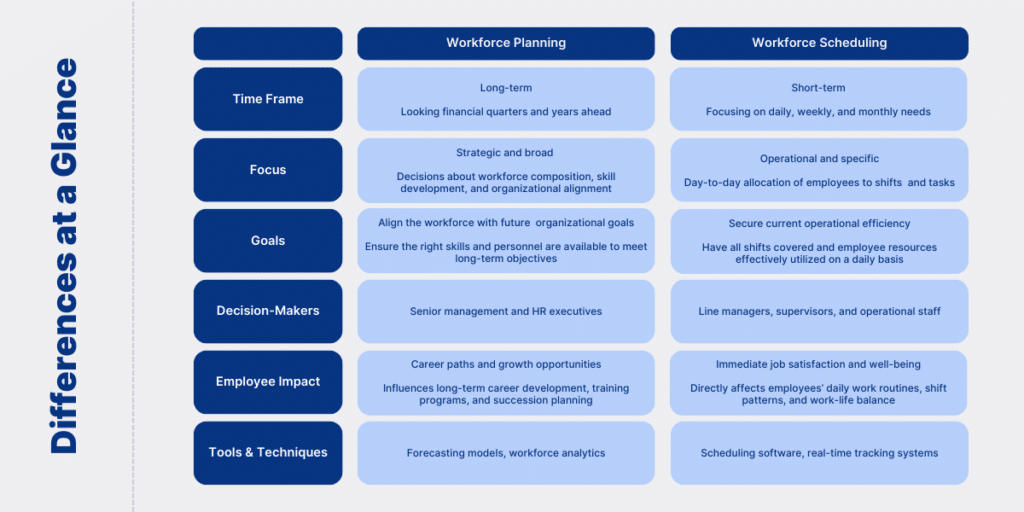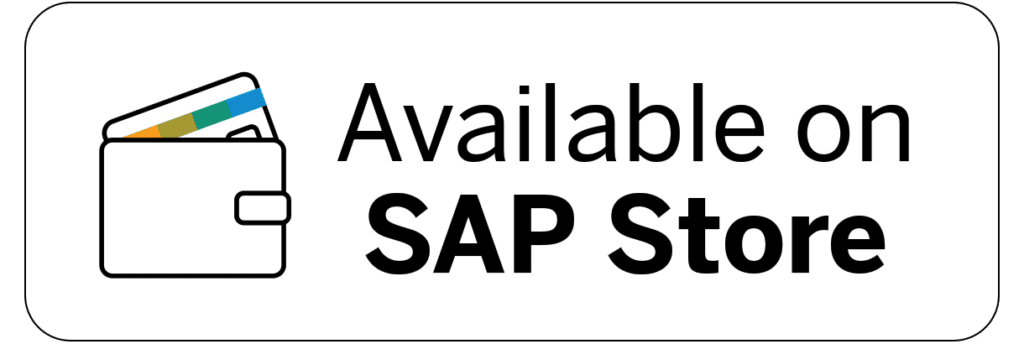Labor-based organizations must navigate a complex web of employee skills, availability, and regulatory requirements, all while striving to meet their operational goals and growth objectives. This is where workforce planning and workforce scheduling come into play—two essential processes that, when combined, create a comprehensive approach to workforce management.
A common misconception is that these processes are one and the same, and it’s not unusual for them to be used interchangeably. Let’s dive into the differences and explore why each is indispensable for optimizing resource utilization, maintaining employee satisfaction, and achieving operational excellence.
What is Workforce Planning?
Workforce planning is a strategic long-term vision and process that ensures an organization has the right number of people with the right skills at the right time. This involves several key activities:
- Anticipating Future Needs: Analyzing trends, future projects, and growth forecasts to determine the skills and number of employees needed in the future. This helps in preparing for market changes and business expansion.
- Assessing Current Resources: Reviewing the current workforce to identify skill gaps, surpluses, or shortages. This assessment is critical for understanding where the organization stands in terms of workforce capabilities.
- Developing Strategies: Formulating strategies to align the workforce with the organization’s goals, which may involve hiring, training, re-skilling, or organizational restructuring. These strategies ensure the organization can meet its objectives efficiently.
- Risk Management: Identifying potential risks related to workforce supply and demand—such as aging workforce, skill shortages, or economic downturns—and developing mitigation plans.
- Succession Planning: Preparing for future leadership needs by identifying and developing internal talent to fill key roles, ensuring business continuity.
- Technology Integration: Leveraging advanced analytics and workforce planning software to enhance accuracy in forecasting and decision-making. This integration helps manage large datasets and provide actionable insights.
- Stakeholder Engagement: Involving key stakeholders, including HR, finance, and department heads, to ensure the workforce plan aligns with overall business strategy and departmental needs.
- Long-Term Focus: Workforce planning typically looks several years ahead, making it a long-term strategic process. This foresight helps in building a sustainable workforce that can adapt to future challenges and opportunities.
What is Workforce Scheduling?
Workforce scheduling, in contrast, is more operational and tactical. It focuses on the day-to-day and shift-to-shift allocation of resources to ensure smooth operations:
- Allocating Specific Shifts: Determining which employees work at specific times and on specific days. This is crucial in industries like healthcare, retail, and manufacturing, where operations may continue around the clock. Effective shift allocation helps balance workloads and optimize productivity.
- Managing Day-to-Day Operations: Ensuring all shifts are covered and that there are enough employees to handle the expected workload. This management prevents disruptions in service and maintains operational efficiency.
- Adjusting for Absences and Peaks: Quickly adapting schedules to accommodate unexpected absences or sudden increases in demand. This flexibility is vital for maintaining service levels and meeting customer expectations.
- Compliance with Labor Laws: Ensuring schedules adhere to labor laws and regulations, including maximum working hours, minimum rest periods, and fair distribution of shifts. Compliance helps avoid legal issues and maintains employee trust.
- Employee Preferences and Availability: Considering employee preferences and availability when creating schedules. This improves employee satisfaction and retention by promoting a better work-life balance.
- Use of Technology: Leveraging scheduling software and tools to automate and streamline the scheduling process. These tools can help in manage complex schedules, reduce administrative burdens, and minimize errors.
- Cost Management: Balancing labor costs by optimizing the number of employees scheduled to work based on forecasted demand. Effective cost management prevents unnecessary overtime and reduces operational expenses.
- Communication and Transparency: Maintaining clear and open communication with employees about their schedules. Transparency helps in building trust and ensures employees are informed about any changes in their shifts.
- Short-Term Focus: Scheduling is generally focused on immediate or near-term needs, typically ranging from weekly to monthly planning. This short-term focus allows for responsiveness to daily operational challenges.

Why Both Processes Are Critical
Your plan is only as good as your schedule. Both workforce planning and workforce scheduling are vital for comprehensive workforce management.
In essence, workforce scheduling operationalizes the strategic goals set by workforce planning, ensuring daily activities align with long-term objectives. Without effective scheduling, even the best-laid plans can lead to inefficiencies and employee dissatisfaction. By understanding and implementing both processes effectively, organizations can achieve a balance between strategic foresight and operational excellence, leading to sustained success. Simply put, you cannot execute a plan unless you have the right solutions in place.
Here are the major benefits:
Optimal Resource Utilization
Effective scheduling ensures the planned human resources are utilized efficiently, preventing overwork or underutilization. For example, in a retail environment, strategic planning can project a need for additional staff during the holiday season. Proper scheduling ensures these staff members are available and efficiently deployed to meet customer demand.
Adaptability to Change
Dynamic scheduling allows organizations to adapt quickly to changes such as market demands or employee absences. In healthcare, for instance, sudden spikes in patient admissions can be managed effectively if the workforce plan includes a pool of on-call staff who can be scheduled at short notice.
Employee Satisfaction
Proper scheduling improves work-life balance, job satisfaction, and retention. In industries with variable hours, such as hospitality, providing employees with predictable and fair schedules can reduce turnover and improve morale.
Compliance and Risk Management
Enterprises must ensure adherence to labor laws, regulations, and union agreements to avoid legal penalties and reputational damage. For example, in the food processing industry, compliance with safety and hygiene standards is critical. Workforce planning can identify the need for employees with specific certifications in food safety. Scheduling ensures that these certified employees are available for each shift, maintaining compliance with regulations and passing audits while achieving production targets in the most efficient manner possible.
Cost Efficiency
Aligns workforce supply with demand, reducing labor costs and efficiently managing overtime. Using manufacturing as an example, careful workforce planning can predict periods of high demand. Meanwhile, precise scheduling can manage shifts to avoid costly overtime while still meeting production targets. Proper workforce planning could also identify the need for part-time employees or a contingent workforce to avoid exceeding full-time hour thresholds that could violate regulations or union agreements; scheduling ensures these part-time hours are accurately tracked and managed.
However, even with the best plan, if the execution isn’t meticulously calculated, the entire strategy can fail. This results in wasted resources, not just in terms of hourly workforce overtime or missed production targets, but also the time spent on labor planning. Improper execution can cause significant ripple effects across the business, leading to broader inefficiencies and disruptions—not only in the current labor plan but upcoming ones due to the lagging nature created by manual processes and data silos.
Strategic Alignment
Workforce planning provides the long-term vision and goals while scheduling translates these into day-to-day actions. For instance, local governments may anticipate an increased need for more mail carriers and post office employees over the holiday season. Scheduling ensures that current demand is met while aligning with the long-term plan for the holiday season.
Scenario Planning
Both processes enable organizations to prepare for various scenarios. In times of economic uncertainty, workforce planning can include scenarios for hiring freezes or downsizing, while scheduling can implement these plans efficiently to minimize disruption while hitting production targets.
Talent Development
Workforce planning identifies future skill requirements and gaps, enabling targeted training and development programs. Scheduling ensures that employees undergoing training are effectively managed so that operations continue smoothly and compliance is maintained.
Improved Forecasting
Integrated workforce planning and scheduling provide better data for forecasting. Accurate scheduling data informs future workforce plans, creating a feedback loop that enhances overall planning accuracy.

Indeavor: One Tool for Both
Indeavor is your all-in-one workforce management platform that excels in both workforce planning and scheduling. The platform seamlessly combines strategic planning with automated day-to-day scheduling, ensuring alignment across all levels.
- Real-Time Adjustments: Quickly adapt to changes in demand or workforce availability with real-time scheduling adjustments. Maintain operational continuity even during unexpected events.
- Data-Driven Insights: Utilize advanced analytics to inform both planning (e.g., skills gaps, peak demand times, etc.) and scheduling decisions, enhancing accuracy and efficiency. Forecast workforce needs and optimize resource allocation.
- Employee Empowerment: Empower employees with a self-service app, improving satisfaction and reducing administrative burden. Give employees greater control over their schedules with features for requesting time off, swapping shifts, and volunteering for overtime.
- Compliance Assurance: Maintain compliance with work rules, union regulations, and local and federal labor laws through automated scheduling rules and alerts. Reduce the risk of violations and associated penalties.
- Easy Communication: Facilitate clear and efficient communication between managers and employees through integrated messaging and notifications. Ensure everyone is informed about schedule changes and important updates.
- Cost Management: Optimize labor costs by aligning workforce supply with demand, minimizing unnecessary overtime, and reducing the costs associated with overstaffing or understaffing. Control labor expenses effectively with precise scheduling that matches to production demands.
With Indeavor, organizations can ensure they have the right people in the right place at the right time—every time. Workforce management becomes a strategic asset, driving immediate operational success and long-term organizational growth.
Looking to maximize resource utilization, enhance employee satisfaction, and ensure operational excellence? Book a demo or give us a call today!







